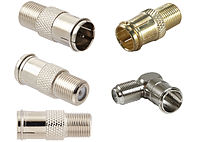F connector
This article includes a list of general references, but it lacks sufficient corresponding inline citations. (April 2012) |
 Male F connector on cable | |||
| Type | RF coaxial connector | ||
|---|---|---|---|
| Production history | |||
| Designer | Eric E. Winston | ||
| Designed | Early 1950s | ||
| Manufacturer | Various | ||
| General specifications | |||
| Diameter | |||
| Cable | Coaxial | ||
| Passband | From 0 Hz to, at least, 2.15 GHz | ||
The F connector (also F-type connector) is a coaxial RF connector commonly used for "over the air" terrestrial television, cable television and universally for satellite television and cable modems, usually with RG-6/U cable or with RG-59/U cable.
The F connector was invented by Eric E. Winston in the early 1950s while working for Jerrold Electronics on their development of cable television.[1] In the 1970s, it became commonplace on VHF, and later UHF, television antenna connections in the United States, as coaxial cables replaced twin-lead. It is now specified in IEC 61169-24:2019.[2]
Description
[edit]The F connector is an inexpensive, gendered, threaded, compression connector for radio frequency signals. It has good 75 Ω impedance match for frequencies well over 1 GHz[2] and has usable bandwidth up to several GHz.
Connectors mate using a 3/8-32UNEF thread. The female connector has a socket for the center conductor and external threads. The male connector has a center pin, and a captive nut with internal threads.[citation needed]
The design allows for low-cost construction, where cables are terminated almost exclusively with male connectors. The coaxial cable center conductor forms the pin, and cable dielectric extends up to the mating face of the connector. Thus, the male connector consists of only a body, which is generally crimped onto or screwed over the cable shielding braid, and a captive nut, neither of which require tight tolerances. Push-on versions are also available.[citation needed]
Female connectors are typically used on bulkheads or as couplers, often being secured with the same threads as for the connectors. They can be manufactured as a single piece, with center sockets and dielectric, entirely at the factory where tolerances can easily be controlled.[citation needed]
This design is sensitive to the surface properties of the inner conductor (which must be solid wire, not stranded).[citation needed]
Weatherproofing
[edit]The F connector is not weatherproof. Neither the threads nor the joint between male connector body and captive nut provide a water-tight seal. However, male connectors are commonly enhanced with an o-ring (of about 7 mm) inside the captive nut. This seals between the mating faces of both connectors, providing some protection for the center conductor.[citation needed]
Alternatively, waterproof versions or enclosures are recommended for outside use (for example, on antennas). Corrosion resistance, reliability of connector electrical conduction and water resistance can be improved by coating all bare copper wires and the connectors themselves with silicone grease. [3]
Usage
[edit]The cable and satellite television entities (as a near standard practice) use compression fittings with F connectors on customer premises. In Europe, block down-converted satellite signals (950–2150 MHz) from LNBs and DC power and block signalling from satellite receivers are near exclusively passed through F connectors.[4]
Flex F connectors
[edit]Push-on (aka Flex) F connectors provide poorer shielding against microwave signals of high field strength. This leakage problem is more an artifact of bent or partly broken push on connectors, but is mostly not observed with compression connectors. Nearby television, FM radio, mobile & cordless phones, government radiolocation (54–1,002 MHz)[5] transmitters can potentially interfere with a CATV or DTH Satellite reception or operation if the Flex connector is poorly installed.
-
F connectors attached to a 4-way DiSEqC switch.
-
A visual collection of standard and right-angle coaxial F connectors, a commonly used but less documented form of the F connector.
See also
[edit]- Belling-Lee connector
- BNC connector
- Coaxial cable
- Component video
- Composite video
- Diplexer
- FME connector
- RCA connector
- Satellite dish
- TV aerial plug
- MCX connector
References
[edit]- ^ Electrical Connector. US Patent 3,537,065 by Eric Winston
- ^ a b "IEC 61169-24:2019: Radio-frequency connectors - Part 24: Sectional specification - Radio frequency coaxial connectors with screw coupling, typically for use in 75 Ω cable networks (type F)". 2019.
- ^ "Dielectric Grease vs. Conductive Grease". www.w8ji.com.
- ^ "Understanding lnb specifications" (PDF). SatCritics Technicals. 2002-11-15. Retrieved 2017-11-29.
- ^ Cityfreq United States Scanner Frequencies, Phone Numbers, and IP Addresses.
Further reading
[edit]- "F" Port (Female Indoor) Physical Dimensions, ANSI/SCTE 02 2015 (see www.scte.org).


